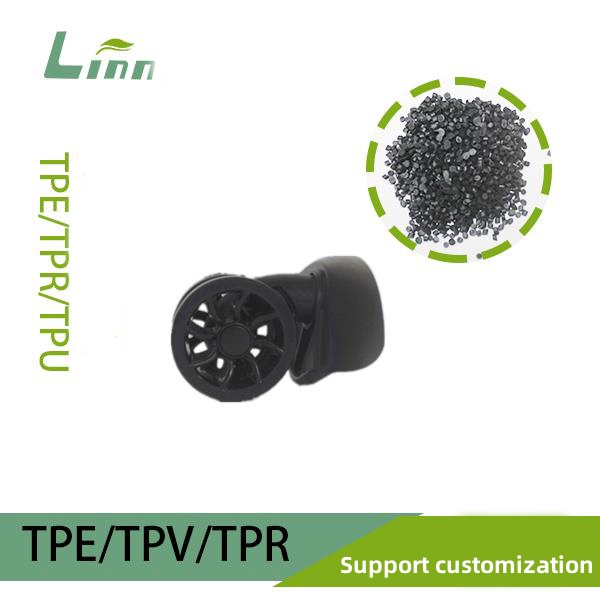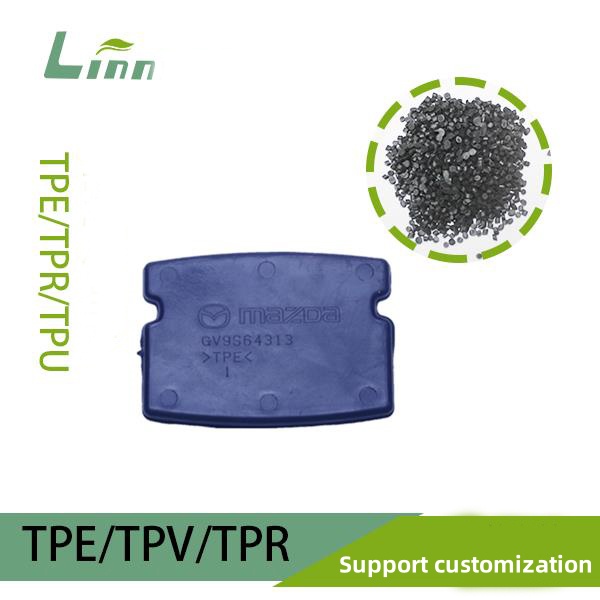As someone who has been deeply involved in the tire and rubber products industry for years, I understand how frustrating it can be to deal with a bulge in a TPE (thermoplastic elastomer) coated wheel. Whether it’s on a stroller, wheelchair, or industrial equipment, a bulge in a TPE-coated wheel not only affects its appearance but can also pose safety risks. In this article, I’ll walk you through the causes of bulges in TPE-coated wheels, how to fix them, and how to prevent them, hoping to help you tackle this tricky issue.

Why Do TPE-Coated Wheels Develop Bulges?
The first time I encountered a bulge in a TPE-coated wheel was through a customer complaint at a stroller manufacturing company. The customer noticed a small bulge on the wheel’s surface that felt elastic when pressed, almost like there was air trapped inside. This prompted me to dive deeper into the issue. Based on years of experience, I’ve identified the following common causes:
Manufacturing Process Issues: During the injection molding or coating process, improper mold temperature, uneven injection pressure, or insufficient cooling time can trap gases inside, leading to bulges.
Unstable Material Quality: If the TPE material has an uneven composition or contains impurities, it may form air bubbles during processing, resulting in bulges.
Environmental Factors: Prolonged exposure to high temperatures, humidity, or strong UV rays can cause TPE material to age, weakening its internal structure and causing bulges.
External Damage: Impact or compression during transportation or use can deform the internal structure, leading to surface bulges.
Design Flaws: If the wheel hub and TPE layer are poorly designed, such as having excessive gaps or weak bonding, the TPE layer may detach under stress, causing bulges.
These causes may sound complex, but the good news is that most bulge issues can be resolved through adjustments or repairs. Below, I’ll guide you step-by-step on how to address them.

How to Adjust a Bulge in a TPE-Coated Wheel?
Before you start fixing the bulge, I strongly recommend assessing the severity of the issue. If it’s a minor bulge (less than 2mm in height, with no obvious cracks), you can attempt a DIY repair. For severe bulges (prominent protrusion, cracks, or impacting functionality), consider replacing the wheel or consulting a professional.
Here are the detailed steps to adjust a bulge in a TPE-coated wheel, written in a way that’s easy to follow:
1. Prepare Tools and Materials
Before starting, gather the following tools and materials:
Utility Knife or Craft Knife: For cutting or cleaning the bulge area.
Heat Gun: To soften the TPE material (control the temperature to avoid scorching).
Adhesive: Use a TPE-compatible glue, such as cyanoacrylate (commonly known as super glue) or a specialized TPE adhesive.
Sandpaper: For smoothing the repaired surface.
Cleaner: Alcohol or a similar cleaner to clean the wheel surface.
Protective Gloves: To safeguard your hands from glue or heat.

2. Clean the Bulge Area
Wipe the wheel surface with a cleaner and a clean cloth to ensure the bulge area is free of dust or grease. If the bulge has cracks or damage, carefully trim the damaged area with a knife, but avoid cutting too deep to preserve the wheel’s structure.
3. Identify the Bulge Type
Bulges typically fall into two categories:
Air Bubble Bulge: Contains trapped air, feels elastic when pressed.
Delamination Bulge: The TPE layer has detached from the hub, often feeling harder.
For air bubble bulges, try this:
Use a sterilized fine needle to gently puncture a small hole at the top of the bulge to release the air.
Press gently with your fingers to help the TPE layer adhere to the hub.
Apply a small amount of TPE adhesive to seal the hole.
For delamination bulges, the process is slightly more complex:
Use a heat gun on low heat (80-100°C) to soften the bulge area.
Press gently with your fingers or a flat tool to reattach the TPE layer to the hub.
If adhesion is weak, inject a small amount of adhesive into the gap to strengthen the bond.
4. Cure and Sand
After repair, let the wheel sit for at least 24 hours to ensure the adhesive fully cures. Then, use fine sandpaper (800-1200 grit) to lightly sand the repaired area for a smooth finish. If needed, apply a TPE-specific protective coating to enhance surface durability.
5. Test and Observe
Once repaired, reinstall the wheel and conduct a low-intensity test (e.g., pushing a stroller on flat ground). Check if the repaired area remains stable and shows no signs of re-bulging. If the issue persists, you may need to replace the wheel.

How to Prevent Bulges in TPE-Coated Wheels?
Fixing a bulge is a temporary solution; prevention is the long-term fix. From my work with various wheel manufacturers, I’ve compiled effective ways to prevent bulges:
Choose High-Quality TPE Materials: Opt for wheels from reputable suppliers to ensure material reliability.
Mind the Environment: Avoid exposing wheels to extreme heat (above 60°C), high humidity, or intense UV light. For outdoor equipment, consider adding wheel covers.
Regular Inspections: Check the wheel surface every 2-3 months to catch potential issues early.
Proper Installation: Ensure the hub and TPE layer are tightly bonded during installation to avoid uneven stress.
Optimize Manufacturing: For manufacturers, refine the injection molding process by controlling mold temperature (120-150°C) and extending cooling time (at least 30 seconds).
To better illustrate the comparison between repair and prevention, here’s a table for reference:
|
Aspect |
Repairing Bulges |
Preventing Bulges |
|---|---|---|
|
Cost |
Low (tools and adhesive cost ~$3-8) |
Moderate (premium materials/processes) |
|
Time |
1-2 hours |
Long-term (ongoing during production/use) |
|
Difficulty |
Moderate (requires some skill) |
Low (focus on material and environment) |
|
Effectiveness |
Short-term, may recur for severe cases |
Long-term, significantly reduces bulges |
|
Best For |
Minor bulges or limited budgets |
High durability or mass production |
Real-Life Case: Fixing a Stroller Wheel Bulge
A few years ago, a mother reached out to me for help with her stroller’s wheel, which developed a bulge after less than a year of use. She said it made the ride bumpy and unsafe for her child. When I inspected it, I found an air bubble bulge caused by insufficient cooling during manufacturing, trapping air inside.
On-site, I used a fine needle to release the air, sealed the hole with TPE adhesive, and completed the repair in under 30 minutes. I advised her to avoid leaving the stroller in direct sunlight and to wipe the wheels regularly to prevent material aging. Two years later, she told me the wheels were still working perfectly and even sent me a box of local treats as a thank-you. This experience reminded me that solving a problem with care can fix more than just a wheel—it can touch someone’s heart.
Industry Data: The Prevalence of TPE Wheel Bulges
According to a 2023 report by Rubber & Plastics News, TPE materials account for over 30% of wheel manufacturing, but bulge-related complaints make up about 15% of after-sales feedback due to manufacturing or material issues. This shows that bulges are a common industry challenge. The report also notes that optimizing molding processes and using high-molecular-weight TPE can reduce bulge rates to below 5%.

FAQs: Answering Your Common Questions
To provide a comprehensive understanding of TPE-coated wheel bulges, I’ve compiled some frequently asked questions and answers:
Q1: Can a TPE-coated wheel with a bulge still be used?
A: A repaired minor bulge can be used, but if the bulge is large or has cracks, replace the wheel to ensure safety.
Q2: Will DIY bulge repairs affect the wheel’s lifespan?
A: If done correctly, repairs won’t significantly impact lifespan. However, using improper glue or overheating can accelerate material aging.
Q3: How do I know if a bulge needs professional repair?
A: If the bulge is over 5cm in diameter, has visible cracks, or reappears after repair, contact a professional or the manufacturer.
Q4: Can bulges in TPE-coated wheels be completely prevented?
A: Complete prevention is challenging, but using high-quality materials, refining manufacturing, and proper usage can minimize the risk.
Q5: What should I consider when replacing a wheel?
A: Choose a wheel matching the original size and load capacity, ensuring a tight bond between the hub and TPE layer to avoid future bulges.
Final Thoughts
A bulge in a TPE-coated wheel can be a hassle, but with the right repair techniques and preventive measures, you can restore your wheel to full functionality. Whether you’re fixing it yourself or opting for a replacement, the key is attention to detail. I hope this guide offers practical solutions, and I invite you to share your experiences or questions in the comments—let’s work together to keep those wheels rolling smoothly!
If you have more questions about TPE-coated wheels or want tips on tire maintenance, feel free to reach out. Helping you solve this problem is what motivates me to share my knowledge!





